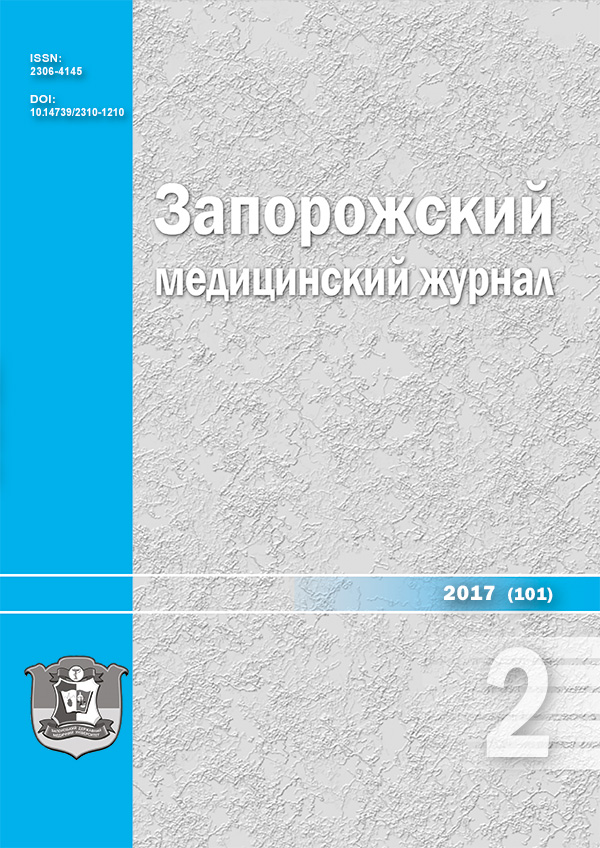The experience of using thoracoscopic surgery for treatment of patients with acute nonspecific parapneumonic pleural empyema
DOI:
https://doi.org/10.14739/2310-1210.2017.2.96025Keywords:
empyema, pleural, thoracoscopy, thoracic surgery, video-assistedAbstract
Objective. To evaluate the effectiveness of thoracoscopic operations and to study the clinical and epidemiological characteristic of patients with pleural empyema (PE).
Materials and Methods. A retrospective analysis of 51 patients with PE treatment results has been done. All participants were examined by standard clinical and laboratory tests, X-rays and CT scans of the chest, ultrasound of pleural cavities. All patients (n = 51, 100%) were subject to thoracoscopic interventions.
Results. The average age of patients was 44.4 ± 14.7 years. Men prevailed among them - 36 (71%). The first stage of PE was diagnosed in 18 (35%) patients, and the second - in 33 (65%). Almost all patients (50 patients – 98%) had been treated in other hospitals before hospitalization to a specialized department. Diagnostics of PE and patients admission to the thoracic surgery department took place on the 2 - 3 week of disease in 70% of cases. The main types of surgery on the first stage of PE were: 1) thoracoscopy with targeted drainage of pleural cavity and pleural biopsy (n = 4, 22%), 2) video-assisted thoracoscopic surgery (VATS) with destruction of fibrinous adhesions (n = 14; 78%). It has been done at the second stage of PE: 1) VATS pneumolysis (n = 22; 67%) and 2) VATS decortication of lung (n = 11; 33%). The positive results of pleural exudates bacteriological analysis have been obtained from 9 patients (18%). The median of pleural exudation duration at the first stage of PE was 5 days (4, 6), at the second stage - 6 (5, 9) days (p = 0.058). Good results were obtained in 33 patients (65%), satisfactory - in 15 (29%), unsatisfactory - in 3 (6%). The median of hospital stay duration was 18 (16; 21). There have not been lethal outcomes.
Conclusions. Diagnosis of pleural empyema is a complex task and requires a broad introduction of modern techniques (CT and ultrasound). Standard microbiological testing is not effective in the diagnosis of PE pathogens, due to imperfection of anaerobic bacteria methods of detection and previous antibiotic therapy. The use of VATS in patients with PE on the first and the second stage is effective and reasonable, leads to good and satisfactory results in 95 % and 94 % of cases respectively.
References
Tsujimoto, N., Saraya, T., Light, R., Tsukahara, Y., Koide, T., Kurai, D., et al. (2015). A Simple Method for Differentiating Complicated Parapneumonic Effusion/Empyema from Parapneumonic Effusion Using the Split Pleura Sign and the Amount of Pleural Effusion on Thoracic CT. PLOS ONE, 10(6), e0130141. doi: 10.1371/journal.pone.0130141.
Burgos, J., Falcó, V., & Pahissa, A. (2013). The increasing incidence of empyema. Current Opinion in Pulmonary Medicine, 19(4), 350–356. doi: 10.1097/MCP.0b013e3283606ab5.
Scarci, M., Abah, U., Solli, P., Page, A., Waller, D., van Schil, P., et al. (2015). EACTS expert consensus statement for surgical management of pleural empyema. European Journal of Cardio-Thoracic Surgery, 48(5), 642–653. doi: 10.1093/ejcts/ezv272.
Grijalva, C. G., Zhu, Y., Nuorti, J. P., & Griffin, M. R. (2011). Emergence of parapneumonic empyema in the USA. Thorax, 66(8), 663–668. doi: 10.1136/thx.2010.156406.
Rahman, N., Maskell, N., West, A., Teoh, R., Arnold, A., Mackinlay, C., et al. (2011). Intrapleural Use of Tissue Plasminogen Activator and DNase in Pleural Infection. New England Journal of Medicine, 365(6), 518–526. doi: 10.1056/NEJMoa1012740.
Rosenstengel, A. (2012). Pleural infection-current diagnosis and management. Journal of Thoracic Disease, 4(2), 186–193. doi: 10.3978/j.issn.2072-1439.2012.01.12.
Shirota, C., & Uchida, H. (2015). Initial treatment of septated parapneumonic empyema with drainage plus fibrinolytic agents is equally effective as video-assisted thoracoscopic surgery, and is suitable as first-line therapy. Translational Pediatrics, 4(1), 41–44. doi: 10.3978/j.issn.2224-4336.2015.02.01.
Maskell, N. A., Batt, S., Hedley, E. L., Davies, C. W., Gillespie, S. H., & Davies, R. J. (2006). The Bacteriology of Pleural Infection by Genetic and Standard Methods and Its Mortality Significance. American Journal of Respiratory and Critical Care Medicine, 174(7), 817–823. doi: 10.1164/rccm.200601-074OC.
Maskell, N. A., Davies, C. W., Nunn, A. J., Hedley, E. L., Gleeson, F. V., Miller, R., et al. U.K. Controlled Trial of Intrapleural Streptokinase for Pleural Infection. (2005). New England Journal of Medicine, 352(20), 2146–2146. doi: 10.1056/NEJMoa042473.
Hajjar, W. M., Ahmed, I., Al-Nassar, S. A., Alsultan, R. K., Alwgait, W. A., Alkhalaf, H. H., & Bisht, S. C. (2016). Video-assisted thoracoscopic decortication for the management of late stage pleural empyema, is it feasible? Annalis of Thoracic Medicine, 11(1), 71–78. doi: 10.4103/1817-1737.165293.
Downloads
How to Cite
Issue
Section
License
Authors who publish with this journal agree to the following terms:
Authors retain copyright and grant the journal right of first publication with the work simultaneously licensed under a Creative Commons Attribution License that allows others to share the work with an acknowledgement of the work's authorship and initial publication in this journal. 
Authors are able to enter into separate, additional contractual arrangements for the non-exclusive distribution of the journal's published version of the work (e.g., post it to an institutional repository or publish it in a book), with an acknowledgement of its initial publication in this journal.
Authors are permitted and encouraged to post their work online (e.g., in institutional repositories or on their website) prior to and during the submission process, as it can lead to productive exchanges, as well as earlier and greater citation of published work (See The Effect of Open Access)

